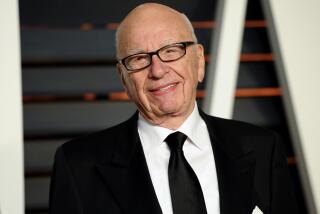Murdoch Takes Leap Toward Worldwide Broadcasting : Media: News Corp., near bankruptcy two years ago, will pay $525 million for a Hong Kong-based satellite TV service.
Rupert Murdoch, in a giant leap toward becoming a global broadcaster, said Monday that his News Corp. will acquire a 63.6% stake in Star TV, the fast-growing Hong Kong-based satellite television service that spans Asia, for $525 million.
The announcement marks a stunning turnaround for the global media baron, who only two years ago teetered near bankruptcy. Now, with Star TV in his communications empire, Murdoch will be the only broadcaster in the world with TV networks on three continents.
Star TV’s five channels--Mandarin- and English-language entertainment channels, MTV, BBC World TV Service and sports--cover more than half the world’s population in a region where the number of TV sets is projected to grow at more than twice the rate of that in the West over the next several years. A sixth channel, broadcast in Hindi, is carried only in India.
Star TV will also bring Murdoch closer to his goal of linking his Fox TV network in the United States with the BSkyB satellite service in Great Britain. In addition, Murdoch is developing a Spanish-language network to cover Latin America.
The eventual linking of those three networks, either through an exchange of programming or shared production facilities and news studios, could form a global TV service that might challenge CNN or the BBC, the current leading purveyors of TV news.
Star TV was launched in August, 1991, and almost immediately provided a significant boost in satellite dish sales to a huge area, stretching from Israel to Taiwan. The satellite TV service is owned by Hutchison Whampoa Ltd., a company controlled by Hong Kong’s Li family, which has interests ranging from real estate to telecommunications.
The move is also likely to pit Murdoch against other aspiring global broadcasters, such as Ted Turner’s CNN, which is now seen in many countries around the world, and companies such as Japan’s Sony Corp., which is sure to look with disfavor at Murdoch’s arrival in its geographical back yard.
Murdoch’s investment in Star TV raises a host of regulatory and cultural issues; he has frequently had his moves checked by local governments that want to restrict entry of private commercial broadcasters. Nowhere is this more evident than in many of the countries that fall under the Star TV satellite “footprint,” where governments seek to control the entertainment and information seen by viewers.
Star TV says it reaches 13 million homes across 38 countries in Asia. A second Star TV satellite is expected to be launched next year, and the company is already talking about using the latest digital compression technology to deliver as many as 180 channels.
Although not the biggest, Star TV is probably the most significant of the private commercial satellite services now becoming available around the world as governments gradually loosen their grip on control of the airwaves. Many viewers in Asia and the Middle East, until recently, could watch only government-run broadcast channels that showed nothing but censored news and American Westerns.
Governments have found it difficult to curb the spread of satellite dishes that can pick up signals from Star TV and other satellite broadcasters. In some areas of Thailand, for example, people have been known to buy a satellite dish before a telephone or air-conditioner.
News Corp., which Murdoch controls, said it would use the library of films and TV programs owned by its Fox studio on the Star TV channels. At present, Star TV features a large quantity of Western-produced films and TV shows because there was not enough locally produced programming to fill the schedules of the five channels.
Independent market research published earlier this year found that about 11 million households, or more than 45 million viewers, could receive Star TV broadcasts. The report, which was based on research in 10 countries, claimed that the largest audience is in China, with 4.8 million households, followed by India with 3.3 million and Taiwan with 2 million.
More to Read
The biggest entertainment stories
Get our big stories about Hollywood, film, television, music, arts, culture and more right in your inbox as soon as they publish.
You may occasionally receive promotional content from the Los Angeles Times.










